
- Usage in publication:
-
- Pennington shale*
- Modifications:
-
- Named
- Dominant lithology:
-
- Shale
- Sandstone
- AAPG geologic province:
-
- Appalachian basin
Summary:
Named Pennington shale. Composed of shale and sandstone, with minor conglomerate and coal. Thickness ranges in area from 890 to 1025 ft. Underlain by Newman limestone; overlain by Lee conglomerate.
Source: GNU records (USGS DDS-6; Reston GNULEX).
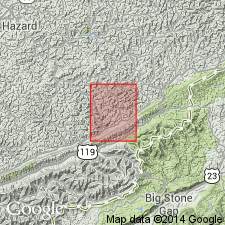
- Usage in publication:
-
- Pennington Formation*
- Modifications:
-
- Age modified
- Biostratigraphic dating
- AAPG geologic province:
-
- Appalachian basin
Summary:
In the description of map units for this eastern KY quadrangle, the Pennington Formation is extended into the earliest Pennsylvanian. The majority of the Pennington is of Late Mississippian age. However, spores from coal and carbonaceous shale of the upper member indicate that the uppermost part of the unit is of Early Pennsylvanian age (R.M. Kosanke, written communication, 1969).
Source: GNU records (USGS DDS-6; Reston GNULEX).
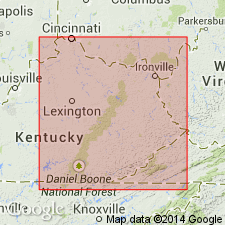
- Usage in publication:
-
- Pennington Shale*
- Modifications:
-
- Areal extent
- AAPG geologic province:
-
- Appalachian basin
Summary:
Rock previously called Pennington Formation along the Cumberland Escarpment in eastern KY, from the northern border to the southern border, renamed the Paragon Formation. Name changed because Pennington has been used along the Cumberland Escarpment in several different ways and different from the original definition. Underlain by Slade Formation (new). Overlain by Breathitt Formation.
Source: GNU records (USGS DDS-6; Reston GNULEX).
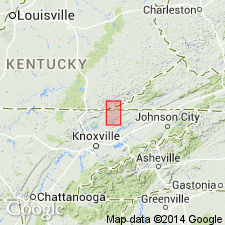
- Usage in publication:
-
- Pennington Formation
- Modifications:
-
- Revised
- AAPG geologic province:
-
- Appalachian basin
Summary:
Pinnacle Overlook Member, a 230-ft resistant sandstone, "properly belongs in the Mississippian Pennington Formation." Usage here agrees with that of Vanover (1989: Eastern KY Univ. M.S. thesis). According to authors, Englund's (1964) interpretation of a Pinnacle Overlook Member of the Lee Formation that intertongues with the upper member of the Pennington was based on a misidentification of the Chadwell Member of the Lee along the ridge at Tri-State-Peak. In this report Pennington Formation unconformably underlies the Chadwell Member of the Lee Formation and the Lee is entirely Pennsylvanian.
Source: GNU records (USGS DDS-6; Reston GNULEX).
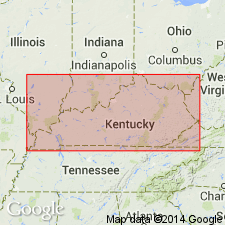
- Usage in publication:
-
- Pennington Group
- Modifications:
-
- Revised
- Overview
- AAPG geologic province:
-
- Appalachian basin
Summary:
Pennington Group in the study area is divided into four formations (ascending): Bluefield, Hinton, Princeton, and Bluestone, which the author states are "projected informally" into KY from VA and WV. Group is described as a heterogeneous unit of red, green, and gray shales, sandstone, limestone, and dolostone. Reaches a maximum thickness of 760 m. Overlies the Poppin Rock Member of the Slade Formation and underlies the Pocahontas Formation or the Warren Point Sandstone of Breathitt Group. Age shown as Mississippian only. Report includes correlation charts, cross sections, and measured sections.
Source: GNU records (USGS DDS-6; Reston GNULEX).

- Usage in publication:
-
- Pennington Formation
- Modifications:
-
- Overview
- AAPG geologic province:
-
- Appalachian basin
Summary:
Pennington Formation mapped in Roane Co., eastern TN. Consists of grayish-red, and light olive- to greenish-gray silty shale; light to medium-gray and yellowish-gray, very fine to fine-grained sandstone; medium-gray to light olive-gray, very fine grained limestone; and light olive-gray dolomite. Formation only locally exposed, but almost always crumpled where seen. Thickness about 400 ft. Overlies Newman Limestone and unconformably underlies Gizzard Group. Age is Late Mississippian.
Source: GNU records (USGS DDS-6; Reston GNULEX).
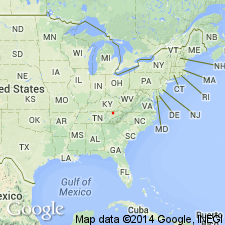
- Usage in publication:
-
- Pennington Formation*
- Modifications:
-
- Revised
- Overview
- AAPG geologic province:
-
- Appalachian basin
Summary:
Report corrects identification of units in pilot bore section by Vanover and others (1989, Itinerary, Day 2-Pilot bore traverse, IN Dean, C.S., and Moshier, S.O., eds., Cumberland Mountain: the inside story: Geological Survey of Kentucky Field Trip Guidebook, p. 24-30) and by Vanover (1989, Pilot tunnel stratigraphy, IN Dean, C.S., and Moshier, S.O., eds., Cumberland Mountain: the inside story: Geological Survey of Kentucky Field Trip Guidebook, p. 39-43). Rocks identified as lower member of Pennington Formation are here re-identified as upper part of upper unnamed member of Newman Limestone. Although Newman-Pennington contact is gradational and therefore may not always be placed at same position everywhere, lower unnamed member of Pennington, as well as that of equivalent Hinton Formation, is resistant, quartzose ripple-bedded Stony Gap Member [of Hinton Formation]. It was misidentified as Pinnacle Overlook Member of Lee Formation by Vanover and others (1989), Vanover (1989), and Watson and Ettensohn (1991, Nature and origin of the Mississippian-Pennsylvanian unconformity in the Cumberland Gap area [abs.]: Geological Society of America Abstracts with Programs, [no volume given], p. 146). Rocks identified as upper member of Pennington are now identified as only the lower part of upper member of Pennington. Rocks identified as Chadwell Member of Lee Formation are now identified as Pinnacle Overlook Member of Lee Formation, which intertongues with Pennington. Rocks identified as uppermost part of Chadwell Member are now re-identified as lower part of upper part of upper unnamed member of Pennington (overlying intertonguing Pinnacle Overlook). Rocks identified as Dark Ridge Member of Lee are here re-identified as upper part of upper part of unnamed upper member of Pennington. Pennington Formation is approximately equivalent to Hinton and Bluestone Formations elsewhere in Appalachian basin. Lower part of Pennington is equivalent to Stony Gap Member of Hinton Formation; these rocks have been traced in central and southern Appalachians from West Virginia to Georgia. Pinnacle Overlook Member and lower part of Chadwell Member, both of Lee Formation, intertongue with both Pennington and Bluestone Formations. Upper part of upper member of Pennington is equivalent to Pride Shale Member of Bluestone Formation elsewhere in Appalachian basin, based on fossil bed common to both units.
Source: GNU records (USGS DDS-6; Reston GNULEX).
For more information, please contact Nancy Stamm, Geologic Names Committee Secretary.
Asterisk (*) indicates published by U.S. Geological Survey authors.
"No current usage" (†) implies that a name has been abandoned or has fallen into disuse. Former usage and, if known, replacement name given in parentheses ( ).
Slash (/) indicates name conflicts with nomenclatural guidelines (CSN, 1933; ACSN, 1961, 1970; NACSN, 1983, 2005, 2021). May be explained within brackets ([ ]).

